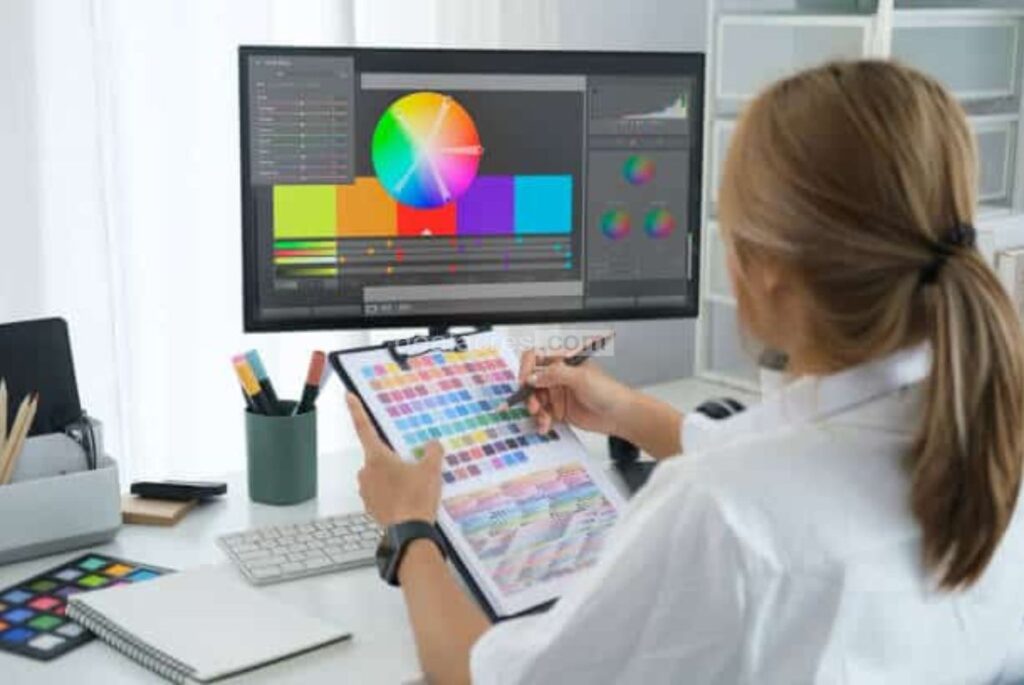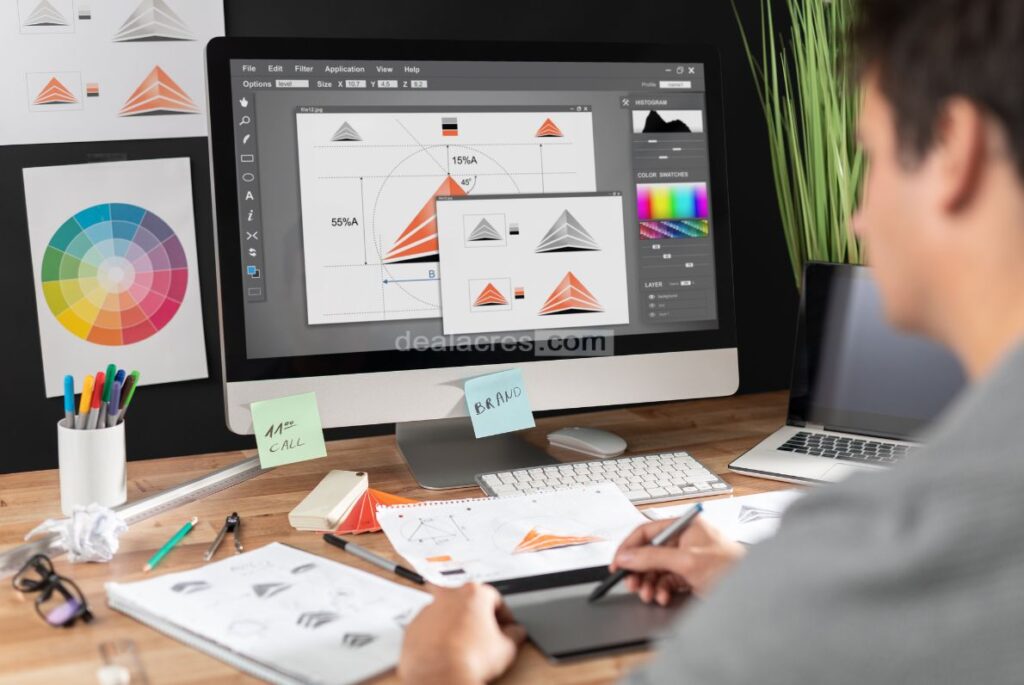Introduction
In the dynamic landscape of the Indian job market, the role of a graphic designer has emerged as a vibrant and sought-after profession. Graphic designers play a pivotal role in shaping visual communication across various industries. This article delves into the expansive job scope of graphic designers in India, unravelling the diverse opportunities, challenges, and creative journeys that define this captivating profession.

Chapter 1: Understanding the Role of a Graphic Designer
1.1 Defining Graphic Design
At its core, graphic design is the art of visual communication. Graphic designers use a combination of creativity, technology, and problem-solving skills to convey messages, ideas, and information through visual elements.
1.2 The Versatility of Graphic Design
graphic designers in India don’t just work on creating aesthetically pleasing visuals; they are storytellers, problem solvers, and brand custodians. Their work spans a multitude of mediums, including print, digital, and multimedia.
1.3 Essential Skills for Graphic Designers in India
From proficiency in design software to a keen eye for detail, graphic designers in India need a blend of technical and creative skills. Effective communication, time management, and adaptability are also crucial in this dynamic field.
Chapter 2: Industries and Sectors Employing Graphic Designers in India
2.1 Advertising and Marketing
In the realm of advertising and marketing, graphic designers craft visuals that captivate audiences. This includes designing advertisements, promotional materials, and branding collateral to enhance brand visibility.
2.2 Print and Publishing
Graphic designers contribute significantly to print and publishing, creating layouts for magazines, books, brochures, and other printed materials. Their role extends to choosing fonts, colours, and images to convey the intended message.
2.3 Web and Digital Media
With the surge in online presence, graphic designers are integral to web and digital media. They design websites, create social media graphics, and ensure a cohesive visual identity across various digital platforms.
2.4 Entertainment and Media
From movie posters to television graphics, graphic designers leave their imprint on the entertainment and media industry. They contribute to visual storytelling through their expertise in motion graphics and animation.
2.5 Corporate and Branding
Graphic designers play a crucial role in corporate branding. They design logos, brand guidelines, and visual elements that define a company’s identity and create a lasting impression on stakeholders.
Chapter 3: Job Roles and Responsibilities of Graphic Designers in India
3.1 Visual Identity Creation
One of the primary responsibilities of a graphic designer is crafting a visual identity. This involves creating logos, choosing colour palettes, and designing elements that represent a brand’s personality.
3.2 Layout and Composition
In print and digital media, graphic designers focus on layout and composition. They arrange text, images, and other visual elements in a visually appealing and communicative manner.
3.3 User Interface (UI) and User Experience (UX) Design
In the digital realm, graphic designers contribute to UI and UX design. They ensure that websites and applications are not only visually appealing but also user-friendly and intuitive.
3.4 Illustration and Artwork
Graphic designers often bring ideas to life through illustration and artwork. Whether it’s creating custom graphics or enhancing visuals with illustrations, this aspect showcases their artistic flair.
3.5 Animation and Motion Graphics
With the rise of multimedia content, graphic designers may delve into animation and motion graphics. This includes creating dynamic visuals for videos, presentations, and interactive content.
Chapter 4: Tools of the Trade – Design Software
4.1 Adobe Creative Suite
At the heart of a graphic designer’s toolkit lies the Adobe Creative Suite, encompassing software like Photoshop, Illustrator, and InDesign. Mastery of these tools is essential for creating professional and impactful designs.
4.2 CorelDRAW
CorelDRAW is another popular design software that graphic designers use for vector illustration and page layout. It offers a versatile platform for creating intricate designs.
4.3 Canva and Other Online Platforms
For quick and accessible design solutions, graphic designers may leverage online platforms like Canva. While not as advanced as professional software, these platforms cater to simpler design needs.

Chapter 5: Academic and Professional Pathways
5.1 Educational Qualifications
The journey to becoming a graphic designer often starts with obtaining a relevant education. Many aspiring graphic designers pursue bachelor’s degrees or diploma courses in graphic design or related fields.
5.2 Building a Portfolio
In the creative world, a portfolio is a graphic designer’s resume. Aspiring professionals focus on building a strong portfolio showcasing their best work, which becomes a testament to their skills and style.
5.3 Internships and On-the-Job Learning
Real-world experience is invaluable for graphic designers. Internships and on-the-job learning opportunities provide exposure to industry practices, client interactions, and the fast-paced nature of the profession.
Chapter 6: Challenges Faced by Graphic Designers in India
6.1 Balancing Creativity and Client Requirements
One of the significant challenges graphic designers face is finding the balance between expressing their creativity and meeting the specific requirements and preferences of clients.
6.2 Meeting Tight Deadlines
In the fast-paced world of design, meeting tight deadlines is a common challenge. Graphic designers often navigate time constraints while maintaining the quality of their work.
6.3 Keeping Abreast of Design Trends
The design landscape evolves rapidly with emerging trends and technologies. Staying updated on design trends is a challenge, but it is crucial for remaining relevant and competitive.
Chapter 7: Future Trends and Innovations in Graphic Design
7.1 Integration of Augmented Reality (AR) and Virtual Reality (VR)
The future of graphic design sees an integration of AR and VR, offering immersive and interactive experiences. Graphic designers may explore new dimensions in storytelling and engagement.
7.2 Sustainable Design Practices
With a growing emphasis on sustainability, graphic designers are expected to adopt eco-friendly design practices. This includes using sustainable materials, reducing waste, and promoting environmental awareness.
7.3 Personalization and Dynamic Content
As personalization becomes a focal point, graphic designers will likely explore dynamic content that adapts to user preferences. This may involve creating personalized visuals for individual users.
Chapter 8: The Impact of Graphic Design on Indian Businesses
8.1 Enhancing Brand Image
Effective graphic design enhances the visual appeal of brands, contributing to a positive brand image. This is crucial for attracting customers and building brand loyalty.
8.2 Marketing and Advertising Effectiveness
Graphic designers play a pivotal role in the effectiveness of marketing and advertising campaigns. Compelling visuals capture attention and convey messages more effectively than text alone.
8.3 Economic Contribution
The graphic design industry contributes significantly to the Indian economy. As businesses recognize the importance of visual communication, the demand for graphic design services continues to grow.

Chapter 9: Advice for Aspiring Graphic Designers in India
9.1 Cultivate a Passion for Design
Passion is the driving force behind creativity. Aspiring graphic designers are encouraged to cultivate a genuine passion for design, as it fuels continuous learning and growth.
9.2 Embrace a Diverse Skill Set
The graphic design landscape is diverse, and a broad skill set enhances versatility. Embrace both technical and soft skills to navigate the multifaceted nature of the profession.
9.3 Stay Open to Learning
In a field that constantly evolves, staying open to learning is crucial. Embrace new tools, techniques, and trends to remain adaptable and innovative throughout your career.
Conclusion
As we conclude our exploration of the job scope of graphic designers in India, it’s evident that this profession is a dynamic blend of creativity, technology, and communication. From shaping brand identities to contributing to the visual language of businesses, graphic designers play a pivotal role in the modern professional landscape. The journey of a graphic designer is not just a career but a continuous exploration of artistic expression and visual storytelling, contributing to the vibrant tapestry of India’s creative industries. Here’s to the graphic designers who bring imagination to life and leave an indelible mark on the visual landscape of the nation!




